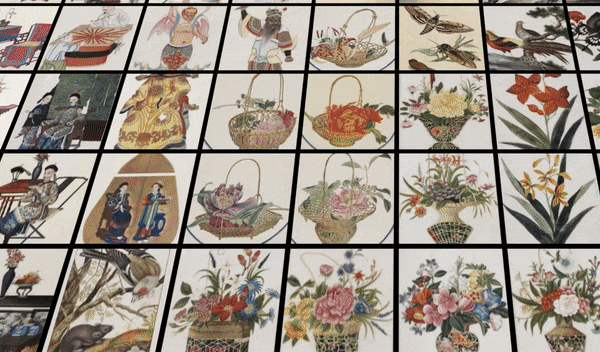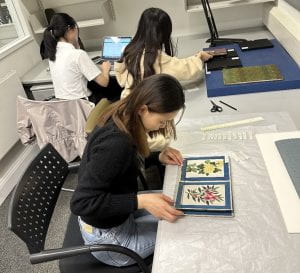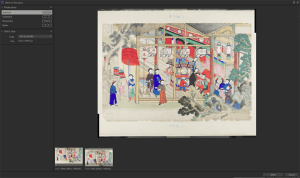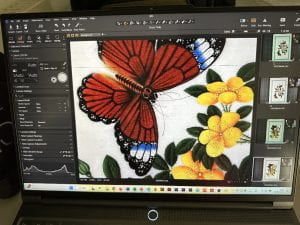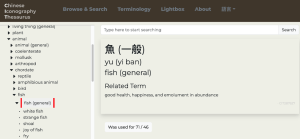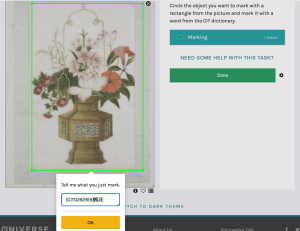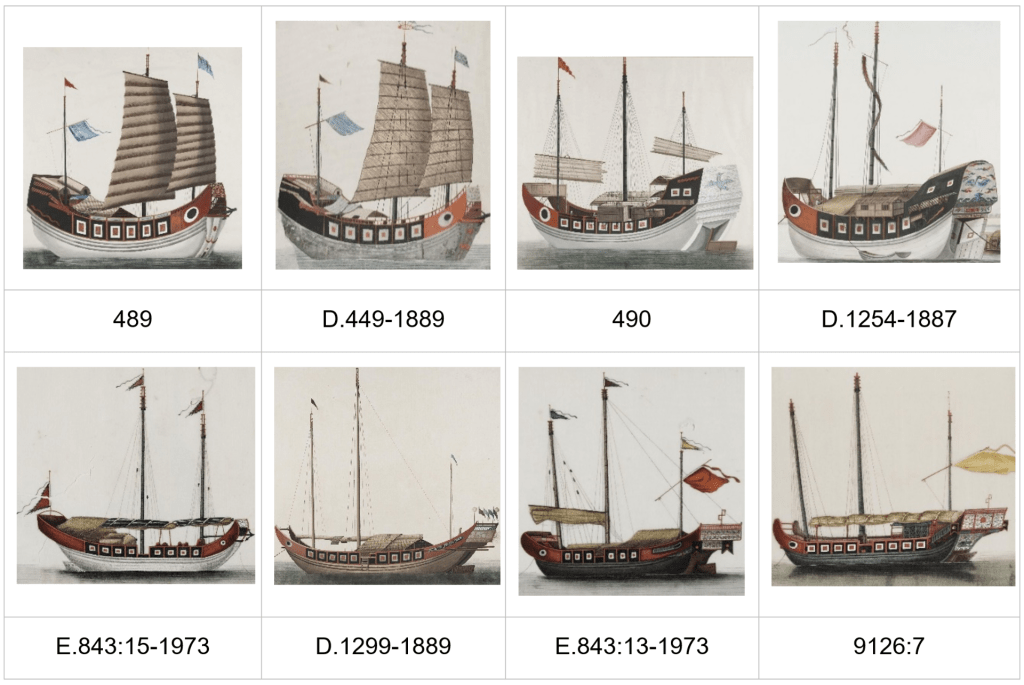A UCL-NHM collaboration on the cataloguing and digitisation of the NHM John Reeves Chinese Export Watercolours collection c.1812-1831
By Jin Gao, on 2 July 2024
Jin Gao, Karoline Hansen, Andrea Hart, Kunwei He, Rebecca Keddie, Charlotte Mang, Jon Nicholls, Ruirui Sun, Jinghang Zhang

Figure 1: Painting selection of the Natural History Museum (NHM)’s John Reeves botanical Chinese Export Watercolours collection, designed for the UCL-NHM CEW project by Karoline Hansen
This blog introduces a collaboration between University College London (UCL) and Natural History Museum (NHM). Co-authored by staff and students, it discusses the Phase I of the UCL-NHM Chinese Export Watercolours (CEW) project, which was carried out in May 2024. It focused on the cataloguing and digitisation of the Museum’s John Reeves botanical drawings collection (c.1812-1831), which comprises 1,057 original watercolour paintings of both wild and cultivated Chinese plants. Interestingly, this project mirrors the collaborative spirit of 200 years ago, when European naturalists and Chinese artists worked together to document and understand the natural world of China (Fan, 2004). Today, our Chinese project members contribute their special knowledge and perspectives, which continues the rich tradition of cultural and scientific exchange that began in the 19th century.
Context
Chinese Export Watercolours (CEW) are a type of paintings produced in China for export to Europe and the North America during the 18th and 19th Centuries. The John Reeves drawings collection at the Natural History Museum (NHM) comprises a unique selection of botanical, zoological, and entomological drawings depicting the natural history of China (Magee, 2011). John Reeves worked for the East India company as Assistant Tea Inspector in Canton but through his interest in natural history he actively worked to further European knowledge of Chinese natural history developing contacts with merchants, officials and craftsmen. He would proceed to commission local artists to depict the flora and fauna he encountered. The drawings produced differed from the traditional artwork created for the European market, referred to as Chinese export paintings, with Reeves and then his son, John Russell Reeves, providing instruction on the subject, detailing the conventions for botanical and zoological illustration. The result is a collection of outstanding paintings which are important not only for their striking beauty and accuracy, but also for their scientific significance (Figure 1). John Russell Reeves inherited his father’s collection of natural history drawings and after his death in 1877 they were presented to the British Museum by his wife.
To enable this collection of botanical drawings to be made more accessible for study and research, in Spring 2024, UCL (University College London) and NHM came together and developed the UCL-NHM Chinese Export Watercolours (CEW) project. Co-led by Jin Gao, Lecturer in Digital Archives at UCL, and Andrea Hart, Library Special Collections Manager at the NHM, the resulting project involved 4 staff from both institutions and 5 students from the MA/MSc Digital Humanities programme as their optional work placements (See Figure 2).

Figure 2: The project team photo. From left: Karoline Hansen (MA student in Digital Humanities, UCL), Kunwei He (MA student in Digital Humanities, UCL), Ruirui Sun (MA student in Digital Humanities, UCL), Rebecca Keddie (Digital Special Collections Librarian, NHM), Charlotte Mang (MA student in Digital Humanities, UCL), Jinghang Zhang (MA student in Digital Humanities, UCL), Jin Gao (Lecturer in Digital Archives, UCL), Jon Nicholls (Digitisation Technician, NHM), Andrea Hart (Library Special Collections Manager, NHM)
Insights from project members
The diverse reflections of the project members, especially students, showed the collaborative nature of this project, where each brought a unique perspective to understand and appreciate the Reeves botanical drawings collection.
The cataloguing team shared their experience of handling and discovering from the original paintings:
Karoline Hansen – “Handling original paintings created by Chinese artists centuries ago allowed me to more deeply comprehend the history of natural history. The human element was brightly evident through the style of the paintings, layers on layers of inscriptions, hidden watermarks revealed only by torchlight, and now by our own contributions of cataloguing and metadata (Figure 3).
The style of the paintings was especially interesting to me, as they diverged from the classic Chinese pursuit of the perfect image which I am more used to. Flat lay cross-sections accompanied browning leaves, and roots stretched from the stems of flowers. This was the clear mark of a Western interpretation of local flora. I grew familiar with strangers’ recurring handwriting as I honed my interpreting skills. Working on a diverse team with so many skills was an incredible boon to the project, and we relied on each other for our varying specialties. I even found myself texting my mother for her well of knowledge about Chinese history, and her contributions joined our own in the translation section of some local flower names.
It was a true pleasure to nurture my curiosity in the natural world. But, even more so, I gained a massive appreciation for how history is not only recorded, but made.”
Charlotte Mang – “As part of the Cataloguing Team for the NHM John Reeves CEW collection, I learned to decipher difficult handwritings and inscriptions while carefully handling artworks. Although measuring the artworks’ dimensions and verifying information can be repetitive, it allowed me to engage closely with the art, whether by examining or admiring it, and to gain interesting botanical knowledge while contributing to its preservation and digitisation within a museum setting. We discovered intriguing watermark variations, such as the prominent J WHATMAN mark, often accompanied by the year of paper production and sometimes “TURKEY MILL,” denoting its origin at the original J WHATMAN paper mill. James Whatman revolutionised papermaking with wove paper at Turkey Mill in the 1750s, enhancing its strength and smoothness through innovative techniques involving gelatine baths. This superior quality not only preserved artworks better but also facilitated artistic experimentation. Another fascinating discovery was a watermark featuring “V E I C” atop a heart-shaped logo, symbolising the United East India Company’s legacy and luck.
Beyond the watermarks, the languages used, particularly in the names of Chinese plants and fruits, reveal cultural connections across Southeast Asia, especially Malaysia, Indonesia, and sometimes the Philippines. Each artwork, through its inscriptions or intricate details, offered a deeper appreciation for botanical diversity and historical narratives. The quality of these watercolour paintings never ceased to amaze me, especially the various depictions of fruits that remind me of home, including watermelon, durian (my favourite fruit!), mango, dragon fruit, coconut, lychee, rambutan, mangosteen, and many more. I also randomly discovered that John Reeves and I attended the same school in England. By helping make these paintings more accessible to the public, I feel more connected to this project in more ways than one.”
Jinghang Zhang – “The First Opium War in 1840 between the Qing Dynasty and the British Empire is often regarded as the beginning of modern Chinese history. After this conflict, China, which had maintained a “glorious isolation” for centuries, is believed to finally start to open its doors and clumsily engage with the globalisation tide. This narrative has become so ingrained that the foreign interactions of China before 1840 are frequently overlooked. Most people’s knowledge of this period is limited to the idea that Canton (nowadays Guangzhou) was the sole window for China’s interactions with the outside world.
The export paintings in this project were created during this overlooked era by Chinese artists in Canton, commissioned by their Western patron, which are invaluable primary sources that deepen our understanding of Sino-Western cultural interactions of that time. Whilst rooted in the traditional Song dynasty bird-and-flower painting techniques, these export paintings also show significant Western influences. Such influences can be traced back to the 18th-century Western painters who served at the Qing court, outlining a potential path of artistic technique dissemination from the court to the public. Furthermore, the use of the “Guange” style of Chinese characters in the text inscriptions on the paintings suggests the possible key role of the Chinese intellectual elite in foreign interactions (Figure 5). Additionally, the use of an informal way of romanisation grounded in the Cantonese dialect in these inscriptions indicates that these interactions took place in a relatively unrestrained environment.

Figure 5: an example of the “Guǎn Gé” style of Chinese characters in the text inscriptions on the painting.
These discoveries somewhat challenge the stereotypical view on the Qing Dynasty’s stance towards Western influences before the First Opium War, offering a fresh perspective that allows for a more objective and realistic understanding of that period. For me, the experience of participating in this project has been like a journey of discovery built upon time travel. The process of uncovering long-hidden truths beneath the dust of history has brought me immense satisfaction.
These reflections underscore the collaborative and interdisciplinary essence of the project, bridging past and present through a shared passion for art and history.”
The photography team members provided insights into the technical and collaborative aspects of digitising the Reeves botanical collection:
Kunwei He – “Being part of the Photography Team for the John Reeves collection has been an incredibly rewarding experience. We use colour checkers to ensure accurate colours, conduct focus checks for clarity, and meticulously examine each painting to digitise every detail. We adhere to strict protocols for naming, converting, and saving images. While this may sound straightforward, it demands intense concentration to avoid any mix-ups and ensure high-quality output.
What makes this job truly fascinating are the unexpected discoveries. Opening each box feels like unwrapping a surprise gift — every painting is uniquely captivating and stunning. The joy of stumbling upon depictions of favourite plants or fruits is beyond words (See Figure 6 and 7).
Zooming in to 100% on the screen reveals hidden details and the intricate brushstrokes that bring the artwork to life. It’s a fascinating exploration of artistry and craftsmanship (See Figure 8 and 9).
Additionally, uncovering paintings with striking resemblances has piqued our curiosity about their origins and the skills of the artists behind them (See Figure 10).
Working with these incredible paintings has deepened my appreciation for art and the meticulous process involved in preserving it. It’s been a journey of discovery and learning, and I look forward to uncovering more hidden gems in the future.”
Ruirui Sun – “The digitisation of the NHM CEW collection has been a very rewarding experience for me. Our photography team developed an efficient workflow that allowed us to handle and process the artworks swiftly. Initially, the workflow involved sequential tasks that had a lot of waiting time, but we soon refined it to allow simultaneous processing and handling, increasing our productivity. This streamlined approach not only improved our efficiency but also enhanced the overall quality of our work. By adhering to NHM standards and meticulously documenting each step, we ensured that the digitised collection accurately reflects the original works.
Our collaboration with the cataloguing team has been incredibly smooth and productive. The written notes in the boxes allowed us to quickly determine whether any action was needed, making it easier for our digitising team and the cataloguing team to switch boxes efficiently. This seamless cooperation significantly contributed to the overall success of the project. Additionally, I appreciate every insight from the cataloguing team, which inspired us from different perspectives and deepened our collective understanding.
As someone born in central China and having lived in Guangdong, I often found delightful surprises during the work. Every time I see a familiar plant depicted in these artworks, it brings a sense of joy and nostalgia. It’s a special privilege to revisit my cultural heritage through the lens of Western artistic styles during the work (Figure 11).

Figure 11: Ruirui Sun (left) and Kunwei He (right), as part of the CEW project group presentation to the NHM Library team, sharing their experiences of digitising the collection.
This project has not only been a professional challenge but also a journey of personal growth and discovery. It has enriched my understanding of both the technical and artistic aspects of digitisation, and I am very excited to see the future outcomes of the CEW project.”
Conclusion and project success
Over the course of the month of May, the 1057 original watercolours were individually catalogued, a process which recorded each artwork’s dimensions, condition, notations, paper and presence of watermarks as well as the include of any Chinese characters which, due to the expertise in the team were transcribed and translated in the metadata. Each work was also imaged so that now a high-quality TIFF file exists for each item. The students were also able to develop their handling skills including an appreciation for the conservation and preservation of artworks on paper in addition to further developing their team work and presentation skills.
The reflections and insights echo the themes discussed in British Naturalists in Qing China by Fa-ti Fan (2004), which explores the complex relationships between Western naturalists and Chinese society. As Fan notes, the success of British naturalists in the 19th century depended heavily on the active participation and knowledge of their Chinese collaborators, which formed flourishing cultural and scientific exchange. This project mirrors that collaborative spirit from 200 years ago and brought together expertise from across regions and disciplines to document and understand China’s natural history.
As a work-in-progress, the future research could continue such collaboration, engage with Chinese botanists and scientists in the identification and study of the plants depicted to enrich our understanding and appreciation of these paintings and potentially shed additional light on other subjects including society and culture. As we move forward, more project updates will be anticipated.
References
Fan, Fa-Ti. (2004) British Naturalists in Qing China. Harvard University Press.
Judith Magee. (2011) Chinese Art and the Reeves Collection: Images of Nature. Natural History Museum.
P.J.P. Whitehead and P.I. Edwards. (1974) Chinese natural history drawings: selected from the Reeves Collection in the British Museum (Natural History). The British Museum (Natural History).
 Close
Close







